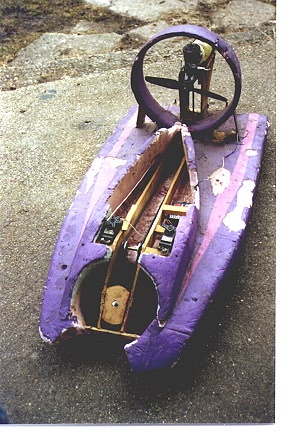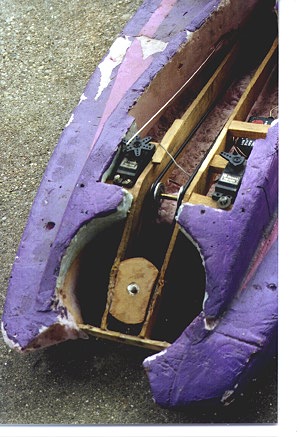1998 Winter Hover-in at Universal Hovercraft, Cordova, Illinois
A bunch of folks and hovercrafts gathered by the Mississippi river, about a mile North of Bob Windt's house -- home of Universal Hovercraft (plans division).From left to right, pictured are Bob's new UH-19P with a variable pitch thrust prop and a very tilted lift duct (more below), my Weber Hovercrafts Starcruiser 2, Bob's new Wing-in-Ground Effect machine, an awfully fast UH-12, and the Webers' personal Starcruiser 4. Not pictured but present were a few more crafts, including Dean Pollee's UH-15TA, and a modified Scat from Missouri. The Mississippi, by the way, is really wide. See that sandy shore in the distance? That isn't the far side of the river -- it is an island. There is some more river after that. And the sandy banks were a fun to skim across.
Here's the WIG taking off. People were mesmerized by the sight of a basically normal hovercraft taking flight (normal in the sense that it would look like a twin engined UH-13 hovercraft if it weren't for the stubby half-foam, half canvas wings)
The WIG operates as an ordinary skirted hovercraft up to about 45 mph and then takes off as its speed increases.
Here it is in level flight. In this prototype, the attitude depended on the weight of the operator -- lightweight operators could get the craft to level-off after takeoff while heavier operators tended to maintain the nose-up position the craft attains during takeoff.
Notice the lack of attention by Dean Pollee (center) and Bob Zang (right). After awhile, people would get accustomed to the spectacle. It left me thinking that WIGs might be a more common sight at future hover-ins.
Bill Zang fuels the lift engine as Bob Windt and Dean Pollee look on. The canvas part of the wings and the wooden spars are removable for trailering.
.
One more picture of the craft taking off (or possibly cruising along in nose-up position -- I'm not sure). That's a UH sportsman class (the Nighthawk) to the left.
This one was one of Bob's latest creations. Rather unusual: The thurst prop had electrically controlled variable pitch (which allowed for reverse thrust), the lift duct was obviously quite tilted, both rotors were belt driven, and single automobile engine providing power was placed toward the front, the passenger sat to the rear of the engine, and the driver sat behind the passenger. How's that for an odd combination of features? The variable pitch thrust wasn't just nice for backing out of parking spaces , it also let the operator overcome a problem typical of single engine crafts: the driver could rev up the lift fan while neutralizing the thrust. Bob told us the forward placement of the engine was chosen for better weight distribution. Oh, and unlike the old UH-19P, the hull was foam.
There's Bob (in back) taking Scott Jindra for a ride as the WIG goes by in hovercraft mode. Scott practiced with the pointed craft during the day, and the next day, he took me for a ride -- it was nice ride until one of the variable-pitch widgets fell apart. Scott put it back together within a few minutes and off we went. Reverse thrust feels weird -- you don't expect to feel prop wash on the back of your head.
Here's a close-up of the variable pitch prop.
Ugh. That's too big. I'll put in a small photo and a description of how it works < here>
A model with a belt-driven lift fan!


A model WIG, again with a belt-driven lift fan. Used a .46 model airplane engine for power. Bob was reluctant to fly it in the backyard for fear that he would run out of room, but the crowd egged him on, and he gave us a show. The craft lifted up into ground effect flight at least once, and maybe a few times -- my memory is hazy -- but after a short time, the nose pitched up and the plane crashed. The only damage was to the wing spars. What really impressed me after that was that they could remove the wings and still use the craft as a grass-riding hovercraft. Guess I've got a one track mind, but I found the grass-riding ability really impressive.